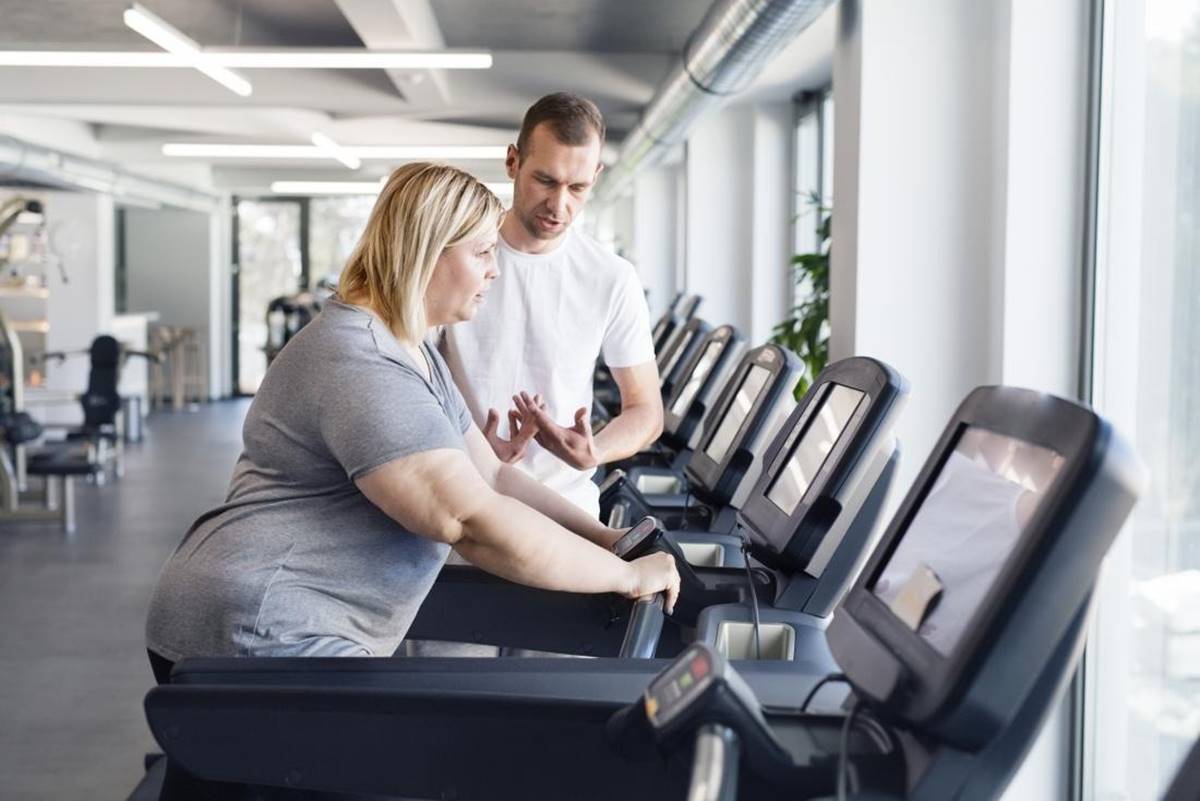Home>Misc>Featured>What Is An Optimum Exercise Intensity For Good Cardiovascular Fitness


Featured
What Is An Optimum Exercise Intensity For Good Cardiovascular Fitness
Modified: August 21, 2023
Discover the featured article on what an optimum exercise intensity is for achieving good cardiovascular fitness. Learn how to maximize your workout for maximum health benefits.
Introduction
Cardiovascular fitness is a key component of overall health and well-being. Engaging in regular exercise not only helps improve cardiovascular fitness, but also promotes weight management, strengthens the immune system, and reduces the risk of chronic diseases such as heart disease and diabetes. However, when it comes to exercise, intensity plays a crucial role in reaping the desired benefits.
Exercise intensity refers to how hard your body works during physical activity. It is often measured using the heart rate, as this indicates the level of exertion. Finding the right exercise intensity is important to ensure that you are challenging your cardiovascular system enough to see improvements, but not overexerting your body to the point of fatigue or injury.
There is no one-size-fits-all approach to determining the optimum exercise intensity. It varies from person to person depending on factors such as age, fitness level, health condition, and personal goals. It is essential to understand the importance of cardiovascular fitness and how to find the right exercise intensity that suits your individual needs.
This article will delve into the concept of exercise intensity, its significance in cardiovascular fitness, and the factors that influence the optimum exercise intensity. We will also provide guidelines for determining the appropriate exercise intensity and discuss the benefits of maintaining it. Furthermore, we will explore the risks of inadequate exercise intensity and the potential consequences on cardiovascular health.
Understanding Exercise Intensity
Exercise intensity refers to the level of effort or exertion required during physical activity. It is a crucial factor in determining the effectiveness of your workouts and achieving desired fitness outcomes. Understanding exercise intensity can help you tailor your workouts to meet your specific goals.
There are various methods to measure exercise intensity, but one of the most commonly used is monitoring your heart rate. Your heart rate provides an accurate reflection of how hard your cardiovascular system is working. The intensity can be classified into different zones, such as low, moderate, and high, based on the percentage of your maximum heart rate.
Another way to measure exercise intensity is through the “talk test.” This method involves assessing your ability to speak while exercising. In low-intensity workouts, you can comfortably hold a conversation. In moderate-intensity workouts, breathing becomes heavier, making it possible to speak in short sentences. In high-intensity workouts, speaking becomes challenging due to intense exertion.
Understanding the different intensities will help you choose the appropriate level of exertion for your workouts. Low-intensity exercise is suitable for beginners, those recovering from an injury, or individuals looking for a gentle workout. It includes activities like walking, yoga, or low-impact aerobics.
Moderate-intensity exercise increases your heart rate and breathing, providing a good cardiovascular workout. This level of exercise is recommended for most individuals and can include activities such as brisk walking, jogging, swimming, or cycling.
High-intensity exercise pushes your body to its limits, significantly elevating your heart rate and breathing rate. It involves activities like sprinting, interval training, or high-intensity interval training (HIIT). High-intensity workouts are beneficial for individuals who are already fit and looking to challenge their fitness level.
It’s important to note that exercise intensity is subjective and can vary between individuals. What may be a moderate intensity workout for one person may be high intensity for another. It’s essential to listen to your body, monitor your heart rate, and adjust the intensity level accordingly to ensure a safe and effective workout.
Importance of Cardiovascular Fitness
Cardiovascular fitness, also known as aerobic fitness, is a measure of how well your heart, lungs, and blood vessels can deliver oxygen to your muscles during physical activity. It is a fundamental component of overall health and plays a significant role in maintaining optimal functioning of the body.
Regular aerobic exercise improves cardiovascular fitness by strengthening the heart muscle, increasing lung capacity, and improving blood circulation. Here are some key reasons why cardiovascular fitness is important:
- Heart Health: Engaging in regular cardio exercise reduces the risk of heart disease by lowering blood pressure, improving cholesterol levels, and reducing the buildup of plaque in the arteries. A healthy heart ensures efficient pumping of blood throughout the body and reduces the strain on the cardiovascular system.
- Weight Management: Cardiovascular exercises burn calories and help in maintaining a healthy weight. Regular aerobic workouts increase metabolism, which aids in weight loss and weight maintenance. Cardio exercises also help reduce visceral fat, the harmful fat stored around the organs.
- Mental Well-being: Cardio exercises stimulate the release of endorphins, which are known as “feel-good” hormones. This helps in reducing stress, anxiety, and symptoms of depression, leading to improved mental well-being and overall mood.
- Energy Levels: Regular aerobic exercise improves the efficiency of the cardiovascular system, resulting in enhanced energy levels throughout the day. It improves oxygen supply to the muscles, reducing fatigue and increasing stamina and endurance.
- Improved Sleep: Studies have shown that regular aerobic exercise can improve the quality of sleep, helping individuals fall asleep faster and experience deeper and more restorative sleep. Adequate sleep is essential for overall health and well-being.
- Prevention of Chronic Diseases: Cardiovascular fitness plays a crucial role in reducing the risk of chronic diseases such as type 2 diabetes, certain types of cancer, and metabolic syndrome. Regular aerobic exercise improves insulin sensitivity, reduces inflammation, and enhances overall immune function.
Incorporating cardiovascular exercise into your routine is vital for maintaining overall health and well-being. Aim for at least 150 minutes of moderate-intensity aerobic activity or 75 minutes of vigorous-intensity aerobic activity per week, along with strength training exercises, as recommended by health experts.
Factors affecting Optimum Exercise Intensity
There are several factors that influence the optimum exercise intensity for each individual. Understanding these factors can help you determine the appropriate level of exertion for your workouts and maximize the benefits of cardiovascular fitness. Here are some key factors to consider:
- Fitness Level: Your current fitness level plays a significant role in determining the appropriate exercise intensity. Beginners or individuals who have been inactive for a long time should start with low to moderate-intensity workouts and gradually increase the intensity as their fitness improves.
- Age: Age affects your exercise capacity and impacts the optimum exercise intensity. As you age, your maximum heart rate naturally decreases, so the target heart rate zones may differ from those of younger individuals. It is important to consult with a healthcare professional to determine the correct exercise intensity based on your age.
- Health Condition: Your overall health condition and any chronic illnesses or injuries need to be taken into account when determining the optimum exercise intensity. Certain medical conditions may require modifications or restrictions on exercise intensity. Consult with your healthcare provider for personalized guidance.
- Goals: The goals you have for your exercise regimen will influence the optimal intensity. If your goal is weight loss, you may need to incorporate higher-intensity workouts to burn more calories. If your goal is to improve cardiovascular endurance, longer duration exercises at a moderate intensity may be more suitable.
- Time Availability: The time you have available for exercise can also impact the optimum exercise intensity. If you have limited time, high-intensity interval training (HIIT) may be a more efficient option, as it allows you to achieve a significant cardiovascular workout in a shorter amount of time.
- Personal Preference: Your personal preference and enjoyment of certain types of exercise can influence the optimum exercise intensity. It’s important to choose activities that you enjoy and that are sustainable for long-term adherence to your workout routine.
Considering these factors will help you determine the appropriate exercise intensity that aligns with your individual needs and goals. Gradually increasing the intensity over time and monitoring your body’s response will ensure a safe and effective workout regimen.
Guidelines for Determining Optimum Exercise Intensity
Finding the right exercise intensity is crucial for maximizing the benefits of cardiovascular fitness. While there is no one-size-fits-all approach, there are guidelines you can follow to determine the optimum exercise intensity for your workouts. Here are some key considerations:
- Maximum Heart Rate (MHR): The maximum heart rate is the highest heart rate you can achieve during intense exercise. It can be estimated by subtracting your age from 220. This estimation provides a rough guideline for determining the target heart rate zones for different exercise intensities.
- Target Heart Rate Zones: Target heart rate zones are ranges of heart rates that correspond to different exercise intensities. For moderate-intensity exercise, aim for a target heart rate of 50-70% of your maximum heart rate. For high-intensity exercise, aim for a target heart rate of 70-85% of your maximum heart rate.
- Talk Test: The talk test is a simple way to gauge exercise intensity. During moderate-intensity exercise, you should be able to carry on a conversation comfortably. During high-intensity exercise, it should be more challenging to speak in full sentences.
- Rate of Perceived Exertion (RPE): The rate of perceived exertion is a subjective measure of how hard you feel your body is working during exercise. It is measured on a scale of 1-10, with 1 being very light exertion and 10 being maximum effort. Aim for an RPE of around 5-6 for moderate-intensity exercise and an RPE of 7-8 for high-intensity exercise.
- Gradual Progression: It is important to gradually increase the intensity of your workouts over time. This allows your body to adapt and prevents the risk of injury. Start at a comfortable intensity level and slowly increase the duration or intensity of your workouts as your fitness improves.
- Listen to Your Body: It’s essential to listen to your body and be aware of any signs of overexertion or excessive fatigue. If you experience dizziness, chest pain, or severe shortness of breath, stop exercising and seek medical attention. Adjust the intensity level based on how your body feels.
Remember that these guidelines are general recommendations, and individual variations should be taken into account. Factors such as fitness level, age, and health condition can influence the appropriate exercise intensity. Consulting with a healthcare professional or a qualified fitness trainer can provide personalized guidance and help you determine the optimal exercise intensity for your specific needs.
Benefits of Maintaining Optimum Exercise Intensity
Maintaining the optimum exercise intensity during your workouts can lead to a wide range of benefits for your cardiovascular fitness and overall health. Here are some key advantages of keeping your exercise intensity at the appropriate level:
- Improved Cardiovascular Fitness: Exercising at the right intensity level challenges your cardiovascular system, leading to improvements in heart health and lung capacity. Regular aerobic exercise strengthens your heart muscle, improves blood flow, and increases oxygen delivery to your muscles, enhancing overall cardiovascular fitness.
- Weight Management: Exercising at an optimum intensity helps burn calories, aiding in weight management. By maintaining a consistent exercise routine, you can achieve and maintain a healthy weight. High-intensity workouts, in particular, can boost your metabolism, allowing you to burn calories even after your workout.
- Increase in Endurance and Stamina: When you exercise at the right intensity level, your body adapts by improving its endurance and stamina. Regular moderate-intensity and high-intensity workouts train your body to become more efficient in using oxygen, resulting in increased endurance and the ability to sustain physical activity for longer periods.
- Facilitates Muscle Gain and Toning: Optimum exercise intensity promotes muscle growth and toning. High-intensity exercises, such as strength training or interval training, stimulate muscle fibers, leading to increased muscle mass and improved muscle definition.
- Mood Enhancement: Exercise at the right intensity releases endorphins, which are natural “feel-good” hormones. These endorphins uplift your mood and reduce stress and anxiety. Regular exercise can also improve sleep quality, resulting in better overall well-being.
- Reduced Risk of Chronic Diseases: Maintaining the right exercise intensity level plays a significant role in reducing the risk of chronic diseases. Regular moderate-intensity aerobic exercise can help lower blood pressure, improve cholesterol levels, and reduce the risk of heart disease, stroke, and type 2 diabetes.
- Improved Energy Levels: Engaging in workouts at the optimum intensity level increases your energy levels and combats fatigue. Regular exercise improves blood flow, delivering more oxygen and nutrients to your muscles and organs, leading to increased vitality and overall energy levels.
By maintaining the optimum exercise intensity, you can experience these benefits and enhance your overall health and well-being. Remember to always listen to your body, gradually progress, and consult with a healthcare professional or qualified fitness trainer for personalized guidance. Consistency is key in reaping the long-term rewards of maintaining the appropriate exercise intensity.
Risks of Inadequate Exercise Intensity
Inadequate exercise intensity, or not exercising at a level that challenges your cardiovascular system, can have negative consequences on your overall health and fitness. Here are some risks associated with inadequate exercise intensity:
- Reduced Cardiovascular Fitness: Exercising at an intensity level that is too low may not provide sufficient stimulus to improve cardiovascular fitness. Without challenging your heart and lungs, you may not see significant improvements in endurance, heart health, and lung capacity.
- Minimal Weight Loss or Maintenance: If your exercise intensity is insufficient, it may not be enough to create the calorie deficit needed for weight loss or weight maintenance. Inadequate intensity may result in slow progress or minimal changes in body composition.
- Plateau in Progress: Failing to increase exercise intensity over time can lead to a plateau in progress. Your body may adapt to the current level of exercise, and you may not continue to see improvements in strength, endurance, or overall fitness.
- Inadequate Stress on Muscles: Inadequate exercise intensity can result in minimal stress on your muscles. This can limit muscle growth and strength gains over time. To build and tone muscles effectively, it is important to challenge them with appropriate intensity.
- Mental Stagnation: Exercise at a low intensity may not provide a stimulating challenge for your mind. This can lead to boredom, decreased motivation, and a lack of interest in continuing with your exercise routine.
- Increased Risk of Chronic Diseases: Inadequate exercise intensity may not provide the cardiovascular benefits necessary to reduce the risk of chronic diseases such as heart disease, type 2 diabetes, and certain cancers. Regular moderate to high-intensity exercise is essential for reaping these disease-prevention benefits.
- Suboptimal Mental and Emotional Well-being: Exercise at a low intensity may not release sufficient endorphins, which can impact your mood and overall mental well-being. Higher-intensity exercise is often associated with a stronger release of endorphins, leading to greater mood enhancement and reduced stress.
It’s important to find the right balance when it comes to exercise intensity—challenging yourself enough to see improvements, but not pushing beyond your limits. Gradually increasing the intensity of your workouts over time, listening to your body, and seeking guidance from a healthcare professional or qualified fitness trainer can help you avoid the risks of inadequate exercise intensity and achieve optimal health and fitness outcomes.
Conclusion
Understanding and maintaining an optimum exercise intensity is crucial for achieving and maintaining cardiovascular fitness. By finding the right balance of challenge and safety, you can unlock a multitude of benefits for your overall health and well-being.
Exercise intensity is highly individual and depends on various factors such as fitness level, age, health condition, and personal goals. Monitoring your heart rate, using the talk test, and considering the rate of perceived exertion are effective methods for determining the appropriate intensity level for your workouts.
By maintaining optimal exercise intensity, you can improve cardiovascular health, manage weight effectively, increase endurance and stamina, enhance muscle tone, and elevate your mood. Regular aerobic exercise at the right intensity level also reduces the risk of chronic diseases and boosts overall energy levels.
On the other hand, inadequate exercise intensity can lead to reduced cardiovascular fitness, minimal weight loss or maintenance, stagnation in progress, increased risk of chronic diseases, and suboptimal mental and emotional well-being.
To ensure you are reaping the benefits of exercise and avoiding the risks of inadequate intensity, it is important to gradually progress your workouts, listen to your body, and seek guidance from healthcare professionals or qualified fitness trainers.
Remember, cardiovascular fitness is an ongoing journey, and finding the right exercise intensity is a key component of that journey. Embrace the challenge, select activities that you enjoy, and strive for consistency as you work towards achieving and maintaining optimal cardiovascular fitness.








